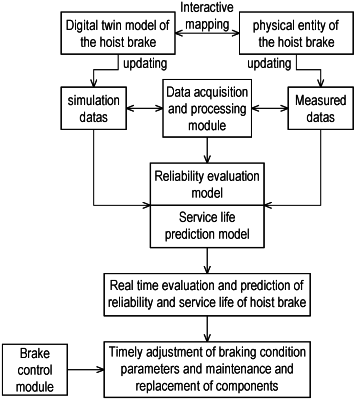| CPC G06Q 10/20 (2013.01) [G06F 30/23 (2020.01)] | 9 Claims |

|
1. An intelligent reliability evaluation and service life prediction method for a kilometer deep well hoist brake, used for an intelligent reliability evaluation on a target hoist brake, comprising:
obtaining a digital twin model corresponding to the target hoist brake through following Steps i to ii;
Step i, establishing, according to structural parameters, material attribute parameters and braking working condition parameters of the target hoist brake, in combination with physical action relations among a brake disc, a brake gate valve and a belleville spring, a three-dimension-structural finite element simulation model corresponding to the target hoist brake, and then entering Step ii;
Step ii, adjusting, based on specified working conditions, the specified working conditions comprising a specified normal braking condition and a specified emergency braking condition, according to a difference of braking torques between a first braking torque generated by a first contact between the brake gate valve and the brake disc of the three-dimension-structural finite element simulation model and a second braking torque generated by a second contact between the brake gate valve and the brake disc of the target hoist brake, parameters for the three-dimension-structural finite element simulation model and the physical action relations among the brake disc, the brake gate valve and the belleville spring, to obtain the digital twin model corresponding to the target hoist brake;
and performing following Steps A to H in accordance with a first preset period duration based on the digital twin model, to implement a real-time reliability evaluation on the target hoist brake, Steps A to H comprising:
Step A, obtaining, by detecting, a first data for the target hoist brake corresponding to each of the structural parameters, each of the material attribute parameter and each of the braking working condition parameters, and a second data for the target hoist brake corresponding to each of braking performance parameters, mapping the first data and the second data into the digital twin model, to implement a synchronous updating with corresponding data in the digital twin model, and then entering Step B;
Step B, establishing, for each of the structural parameters, each of the material attribute parameters and each of the braking working condition parameters respectively, a group of random data for the corresponding data of the digital twin model, wherein a distribution of the group of the random data satisfies a probability distribution of the first data obtained in Step A;
further obtaining combinations of different random data among the structural parameters, the material attribute parameters and the braking working condition parameters, wherein the combinations are used as groups of combined random parameters corresponding to the digital twin model, and then entering Step C;
Step C, obtaining, for the specified normal braking working condition and the specified emergency braking working condition respectively, random responses to the braking performance parameters in the digital twin model corresponding to the groups of the combined random parameters respectively under each of the specified working conditions, and then entering Step D;
Step D, taking, for each braking performance parameter respectively, according to the random responses to the braking performance parameters in the digital twin model corresponding to the groups of the combined random parameters respectively under each of the specified working conditions, the groups of the combined random parameters as an input, and the braking performance parameters corresponding to the groups of the combined random parameters respectively as an output, to construct a training data sample library corresponding to the braking performance parameters, and then entering Step E;
Step E, constructing, for the braking performance parameters respectively, according to the training data sample library corresponding to the braking performance parameters, model functions corresponding to the braking performance parameters respectively, wherein the model functions are used as random response surface models corresponding to the braking performance parameters respectively, and then entering Step F;
Step F, establishing, according to the random response surface models corresponding to the braking performance parameters respectively, in combination with a threshold value for each of the braking performance parameters corresponding to the target hoist brake, reliability evaluation models corresponding to the braking performance parameters respectively, and then entering step G;
Step G, performing, for a third data for the braking working condition parameters obtained by detecting the target hoist brake, according to the reliability evaluation models corresponding to the braking performance parameters respectively, a statistical moment analysis by adopting a knowable moment, further adopting a high-order moment approximation method based on the knowable moment to obtain reliability results corresponding to the braking performance parameters respectively, thereby obtaining a comprehensive reliability result, and then entering Step H after adjusting the braking working condition parameters for the target hoist brake when the comprehensive reliability result is lower than a preset safety threshold.
|